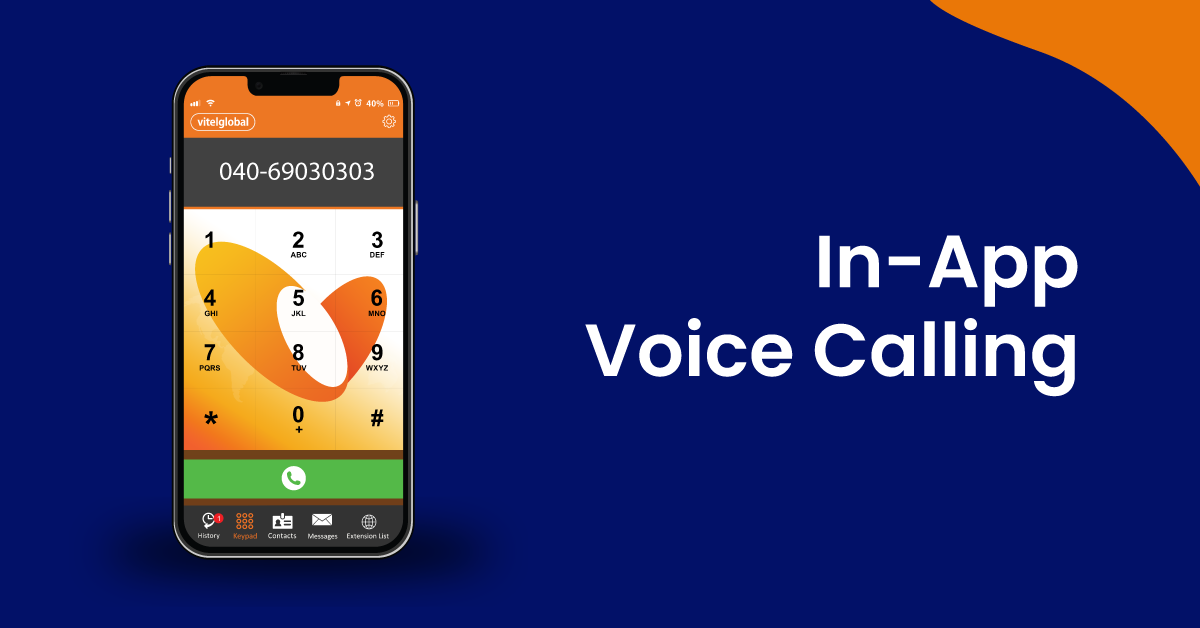To stay competitive, streamline processes, and provide better customer service, companies constantly search for new and creative ways to do things. To reach these ends, in-app voice calling is one piece of technology that has become quite popular.
Businesses may provide the best and most customized user experience by adding voice communication features straight into their web or mobile applications. In-app voice calling is analyzed in this blog, along with its workings, integration procedure, effects on business operations, best practices for deployment, and a summary of its advantages.
How Does In-App Calling Work?
In-app calling uses Voice over Internet Protocol (VoIP) technology to start voice communication within an application. Unlike traditional telephony, which depends on physical network connections, VoIP converts voice signals into digital packets sent over the internet by VoIP mobile apps. This process begins when a user initiates a call within the application.
Through the app sending a request to the server, the caller and the recipient establish a connection over the internet. This connection shows between two app users or between an app user and a traditional phone network, depending on the service’s architecture.
What makes in-app calling so appealing is its many feature sets and variety of options, which include voice mail, call recording, multi-party calling, and encryption for security. Users can use it to make calls from PCs, tablets, and smartphones across various platforms as long as there is an internet connection.
How to Integrate In-App Voice Calling?
Using VoIP mobile apps to integrate in-app voice calling into your application is an unusual way to boost user engagement and facilitate communication. Although this integration can initially seem overwhelming, it can be managed and very rewarding with a structured approach. This thoroughly explains each stage necessary to integrate voice calling within an app.
Choose a VoIP SDK or API
Choosing a reliable VoIP SDK or API is the first step towards establishing in-app voice calling. Many cloud phone service providers provide the best cloud voice solutions catered to a variety of application needs. Multiple factors should influence the decision on this, and a few points are discussed below.
- Decide which essential features you require. Do you need basic voice calls, or does your app need the best features like voicemail, call forwarding, and real-time transcription?
- Verify that the SDK or API works with every platform your app is accessible on, including web apps, iOS, and Android.
- Please consider the provider’s infrastructure and its capacity to expand with your user base. The service must be able to accommodate growing call volumes without sacrificing its quality.
Set up the Development Environment
The next important step is integrating the selected SDK or API into your development environment. Let’s look at a few points towards this setup.
- Get the required libraries and incorporate them into your project. It could entail fixing any dependencies and modifying the build paths.
- Configure any server-side components that are necessary. If the supplier offers a cloud solution, this can entail setting up cloud functions or installing particular services on your servers.
- Put authentication into place to guarantee that authorized users can only place and receive calls. This frequently entails creating tokens or API keys and safely storing them inside your application.
Implement Voice Calling Features
With the setup complete, the next phase is to develop the calling features.
- Implement UI elements and logic to allow users to start and answer calls. It includes handling permissions like microphone access.
- Develop the functionality to manage various call states such as dialing, in progress, on hold, and ended. It ensures that users have a clear understanding of the call status.
- Depending on your app’s requirements, integrate additional functionalities like call recording, encryption for security, and even real-time voice transcription or translation if supported by the SDK.
Test Thoroughly
Delivering a dependable in-app calling experience requires testing.
- Create virtual networks (Wi-Fi, 4G, 3G) to ensure call quality is preserved in various scenarios.
- To find any incompatibilities, test across multiple hardware and operating systems.
- Write test cases covering standard user interfaces and uncommon scenarios, like getting a call when the application runs in the background.
Launch and Monitor
After extensive testing, it’s time to release the feature to your user base.
- Consider a phased rollout to monitor performance and get user feedback without affecting all users simultaneously.
- Install monitoring software to monitor the functionality and usage of the feature. Metrics like call quality, failure rates, and user engagement should receive particular attention.
- Seek out user input and be ready to make adjustments over time. User recommendations can provide insightful information about possible improvements or new features.
How Can In-App Voice Calling Streamline Business Operations?
There are several advantages to incorporating in-application voice calling into business operations. These advantages can potentially revolutionize internal communication and customer interactions in organizations. We go into more detail about each benefit below.
Improved Customer Service
In-application voice calling transforms customer service by allowing users and support teams to communicate instantly within the application. When comparing this immediacy to more conventional methods like email or external phone calls, It is possible to reduce response times significantly.
Furthermore, customer support representatives can quickly access user histories and profiles due to its integration with the VoIP mobile app, which enables them to offer specialized and informed assistance.
Since problems can be understood and resolved more quickly, resolution rates are significantly increased by this degree of straightforward and effective interaction. As a result, customers feel and value the support, which boosts their brand loyalty, and trust and substantially improves their happiness.
Enhanced Communication
In-application voice calling, along with VoIP CRM integration, is a valuable tool for internal operations that helps to improve communication between various departments and locations. Teams are frequently dispersed across different regions in today’s globalized business environment, which challenges effective communication.
Instantaneous voice communication is possible from any location at any time, provided there is internet access. Through in-app calling, these restrictions disappear, enabling such convenience. This, in turn, enhances the business’s overall productivity and agility by facilitating faster decision-making, real-time insight sharing, and improved team collaboration.
Increased Engagement
An app’s ability to incorporate voice calling can significantly increase user retention and engagement. The experience becomes more beneficial and exciting when users can communicate with each other through the app by minimizing the hassle of switching between various communication tools and extending the time spent within the application. This integration keeps users inside the app ecosystem.
Businesses can use this to improve user engagement with the app, reward loyal customers, and entice them to try out more features or services. Moreover, in-app calling can foster community development among users by promoting interactions. That goes beyond the app’s core features and strengthens the user’s bond with the app and the brand.
Operational Efficiency
Using in-application voice calling can result in significant cost and operational efficiency gains. Businesses can lessen their dependency on numerous external platforms, simplifying procedures and cutting complexity by combining communication tools into the app. This consolidation can result in significant cost savings on communication hardware and services and streamline the communication infrastructure.
Furthermore, in-app calling can automate and optimize customer service workflows. Such as routing calls to the appropriate department or providing automated responses for common inquiries. This efficiency reduces operational costs and allows staff to focus on more complex tasks, improving productivity and service quality.
What are the Best Practices for Implementing In-App Voice Calling?
Implementing Voice Communication can significantly enhance the user experience of your application. Here are some best practices to consider.
Quality Assurance
Give call quality a top priority. Make sure the audio quality of your Integrated Voice Communication feature is clear, with little distortion or delay. To guarantee that users receive a consistent experience, test the feature on various devices and across multiple network configurations.
Security
Use encryption to preserve user privacy and guarantee the security of voice calls. Use industry-standard encryption protocols to secure voice data transmission and stop unwanted access to sensitive data.
User Permissions
Get their express consent before using the user’s microphone for voice calls. Make it obvious to users how their voice data will be used, and give them the ability to opt-out if they would instead not use the feature.
User Experience
Create a voice call and receive interface in your VoIP mobile apps that is simple to use and intuitive. To improve usability, include functions like call waiting, mute, speakerphone, and call transfer.
Integration with User Interface
Easily incorporate voice-calling features into the UI of your application. Ensure the calling interface is user-friendly and cohesive with the app’s overall design language.
Conclusion
Businesses aiming to improve user experience and streamline operations can benefit significantly from in-app voice calling. Companies can achieve new heights of productivity, client happiness, and engagement by comprehending how it functions, carefully integrating the features, and adhering to best practices. The potential for in-application voice calling to grow business operations will increase as technology advances, making it a crucial factor for any progressive company to contemplate.




